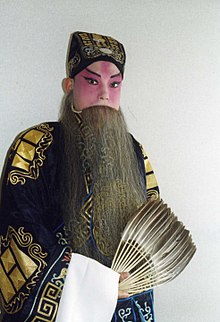Sheng role
| Sheng | |||||||||
|---|---|---|---|---|---|---|---|---|---|
| Chinese | Sinh | ||||||||
| Literal meaning | "scholar" | ||||||||
| |||||||||
Theshengis a role type inChinese operafor dignified and respectable male characters such asConfucianscholars, nobles, or heads of households.[1]They may be portrayed by either male actors or actresses.
Subtypes
[edit]

Theshenghas numerous subtypes. The two major subdivisions are thelaosheng(older gentlemen) andxiaosheng(younger gentlemen), with another important subtype being thewusheng(martial men).[1]Peking operatroupes will always have alaoshengactor. Axiaoshengactor may be added to play roles fitting to his age. In addition to these mainsheng,the troupe will also have a secondarylaosheng.[2]
Laosheng
[edit]Thelaosheng(Chinese:Lão sinh;pinyin:lǎoshēng;lit.'old sheng') is a dignified older role, usually distinguished by a long, thin, three-part beard.[1]These characters have a gentle and cultivated disposition and typically wear long robes withwater sleeves,high-soled boots, and fabric headdresses.[1]
A subcategory iswulaosheng(Chinese:Võ lão sinh;pinyin:wǔlǎoshēng;lit.'martial laosheng'), older generals who have combat skills. They wear armor and helmets instead of robes and fabric hats.Guan Yu,the Chinese god of sworn brotherhood, loyalty and righteousness, andZhao Kuangyin,the firstSong dynastyemperor, are the only two characters in the subcategory known ashongsheng(simplified Chinese:Hồng sinh;traditional Chinese:Hồng sinh;pinyin:hóngshēng), a red-faced older male.
Xiaosheng
[edit]Young, beardless male characters are known asxiaosheng(Chinese:Tiểu sinh;pinyin:xiǎoshēng;lit.'young sheng'). They wear paler makeup thanlaoshengcharacters to show their youth.[1]Xiaoshengcharacters are often involved with beautiful young women by virtue of the handsome and young image they project.[3]Depending on the character's rank in society, the costume of thexiaoshengmay be either elaborate or simple.[4]In Peking opera, these characters sing in a high, shrill voice with occasional breaks to represent the voice changing period of adolescence.
The subcategories ofxiaoshengare thewenxiaosheng(Chinese:Văn tiểu sinh;pinyin:wénxiǎoshēng;lit.'civil xiaosheng') and thewuxiaosheng(Chinese:Võ tiểu sinh;pinyin:wǔxiǎoshēng;lit.'martial xiaosheng'). Thewuxiaoshengroles possess martial skills and are frequently young generals. Often, their filigree helmets are appended with two long pheasant feathers known aslingzi(Chinese:Lông công).[1]
Wusheng
[edit]Thewusheng(Chinese:Võ sinh;pinyin:wǔshēng;lit.'martial sheng') is a martial character for roles involving combat. They are highly trained in acrobatics, and have a natural voice when singing.[4]In Peking opera,wushengis further divided into two subcategories based on the character's costume:[1]
- Thechangkao wusheng(simplified Chinese:Trường dựa võ sinh;traditional Chinese:Trường dựa võ sinh;pinyin:chángkào wǔshēng;lit.'long-armor wusheng') are high-ranking warriors who wear armor (kao,Dựa), helmets, and high-soled boots. They mainly use prop weapons.
- Theduanda wusheng(Chinese:Áo quần ngắn võ sinh;pinyin:duǎndǎ wǔshēng;lit.'short-clothes wusheng') are individual fighters or disenfranchised criminals who wear tight jackets and trousers known askuaiyi(Chinese:Mau y;lit.'fast clothing') orbaoyi(Chinese:Báo y;lit.'leopard clothing') and thin-soled boots. Some of them wear a beret known asluomao(simplified Chinese:La mũ;traditional Chinese:La mũ;lit.'gauze hat'). They are more likely to engage in hand-to-hand combat.
Cross-gender acting
[edit]InYue opera,shengroles have been mainly portrayed by actresses. Actresses playing men (sheng) is also common in some southern genres likeTeochew operaandTaiwanese opera.It also appears inPing opera.
In Peking opera,Meng Xiaodongwas perhaps the first female superstar who specialized inshengroles.
References
[edit]- ^abcdefgBonds, Alexandra B. (2008).Beijing Opera Costumes: The Visual Communication of Character and Culture.University of Hawaiʻi Press.pp.3–5.ISBN978-0-8248-2956-8.
- ^Wichmann, Elizabeth.Listening to Theatre: The Aural Dimension of Beijing Opera.University of Hawaii Press.pp. 7–8.
- ^Chengbei, Xu (2006).Afternoon Tea at the Beijing Opera.Long River Press. p. 163.ISBN978-1-59265-057-6.
- ^abUnknown Author (2000)."Peking Opera".It's China Network - TYFO.COM. Archived fromthe originalon June 7, 2007.
{{cite web}}:|author=has generic name (help)
